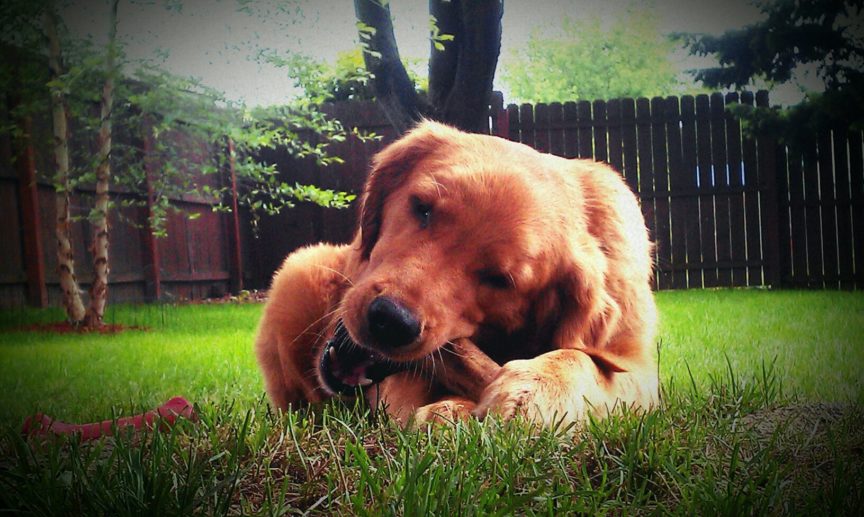Next in the lineup for learning how to be our pet’s hero is choking. We have since covered; cuts, punctures, bites, poisoning, and being hit by a car. While dogs are certainly far more likely to choke than cats – it’s best to know what to do no matter which of your furry pals is in trouble.
Issue: Choking

Choking can occur suddenly in dogs and cats that are chewing on food, treats, or toys. Your pet may suddenly become anxious, start pawing at her mouth, and may struggle to breathe. Her gums may turn blue or gray and she may lose consciousness.
If she is still conscious, extra care should be taken not to get bitten while trying to dislodge the object. If it is safe to do so, you should open her mouth, pull her tongue forward – it might be very slippery from excessive drooling, so using some gauze or other cloth material – and use your finger to try to remove any foreign material from the back of her mouth. If you are unable to remove the object this way, you should perform a modified Heimlich maneuver, depending on the size of your pet.
 For cats and small dogs that can be lifted, hold the pet with the spine along your chest. With one or two hands, make a fist and apply 5 quick thrusts just behind the last ribs in and upward motion pulling toward you slightly. Check your pet’s mouth to see if the object has been dislodged. In larger dogs that you are unable to lift, wrap your arms around his belly with your fists just behind his rib-cage, and while standing behind him, thrust upward and backward 5 times to try to dislodge the object. Alternatively, you can perform the abdominal thrusts with the dog on his side if he is unconscious or tolerates this position better.
For cats and small dogs that can be lifted, hold the pet with the spine along your chest. With one or two hands, make a fist and apply 5 quick thrusts just behind the last ribs in and upward motion pulling toward you slightly. Check your pet’s mouth to see if the object has been dislodged. In larger dogs that you are unable to lift, wrap your arms around his belly with your fists just behind his rib-cage, and while standing behind him, thrust upward and backward 5 times to try to dislodge the object. Alternatively, you can perform the abdominal thrusts with the dog on his side if he is unconscious or tolerates this position better.If your pet is unconscious, and you can see the object (a penlight or flashlight helps with visualization), you can try to remove the object manually. Needle nose pliers may be needed if your dog has a long nose and your hand cannot reach. If you are unable to dislodge the object using the above techniques, you can apply 5 sharps thrusts to your pet’s back between her shoulder blades.
If at any time your pet is unconscious and stops breathing, you should give rescue breaths by covering her nose with your mouth, keeping her mouth closed with your hand, and blowing air into the nose until the chest rises. Interpose 5 rescue breaths with 5 abdominal or back thrusts until the object is dislodged. Depending on how long it takes to dislodge the object – and whether it was completely or partially obstructive – it is possible that your pet may have arrested and you will need to perform CPR. Whether your pet regains consciousness or never lost it to begin with, a pet that has choked should be seen by a veterinarian.
As mentioned in our  previous posts, taking precautions to avoid having your pets choke on something is always your best course of action. However, accidents can and will happen – that ball you were throwing just might get lodged down Bella’s throat and the kibbles that Kit Cat was chomping on could get stuck. Knowing how to act quickly and calmly when your companion is choking will absolutely mean the difference to them. Don’t wait until tomorrow to learn how to be a hero today.
previous posts, taking precautions to avoid having your pets choke on something is always your best course of action. However, accidents can and will happen – that ball you were throwing just might get lodged down Bella’s throat and the kibbles that Kit Cat was chomping on could get stuck. Knowing how to act quickly and calmly when your companion is choking will absolutely mean the difference to them. Don’t wait until tomorrow to learn how to be a hero today.
 previous posts, taking precautions to avoid having your pets choke on something is always your best course of action. However, accidents can and will happen – that ball you were throwing just might get lodged down Bella’s throat and the kibbles that Kit Cat was chomping on could get stuck. Knowing how to act quickly and calmly when your companion is choking will absolutely mean the difference to them. Don’t wait until tomorrow to learn how to be a hero today.
previous posts, taking precautions to avoid having your pets choke on something is always your best course of action. However, accidents can and will happen – that ball you were throwing just might get lodged down Bella’s throat and the kibbles that Kit Cat was chomping on could get stuck. Knowing how to act quickly and calmly when your companion is choking will absolutely mean the difference to them. Don’t wait until tomorrow to learn how to be a hero today.
